Bachelor Thesis: Mass Media's Impact on Self-Presentation (Gone Girl)
VerifiedAdded on 2022/09/28
|35
|13681
|24
Thesis and Dissertation
AI Summary
This thesis, submitted to Ritsumeikan Asia Pacific University, examines the influence of mass media on self-presentation, using the film Gone Girl as a case study. The research explores how media narratives and portrayals shape individual behavior and identity, focusing on the film's characters and symbolism. The study reviews relevant literature on media effects and socialization, employing social cognitive theory to analyze the film's narrative, character development, and ideologies. The analysis investigates the couple's dynamic in the film, exploring how media influences public perception and individual actions within social settings. The conclusion highlights media's power to influence how events and stories are perceived and its subsequent impact on self-presentation. The thesis underscores the pervasive nature of media's influence and its implications for understanding contemporary society. The thesis also acknowledges the support received from the supervisor and other faculty members. The author explores the impact of media on the audience and how it can affect the way people perceive an event or a story.
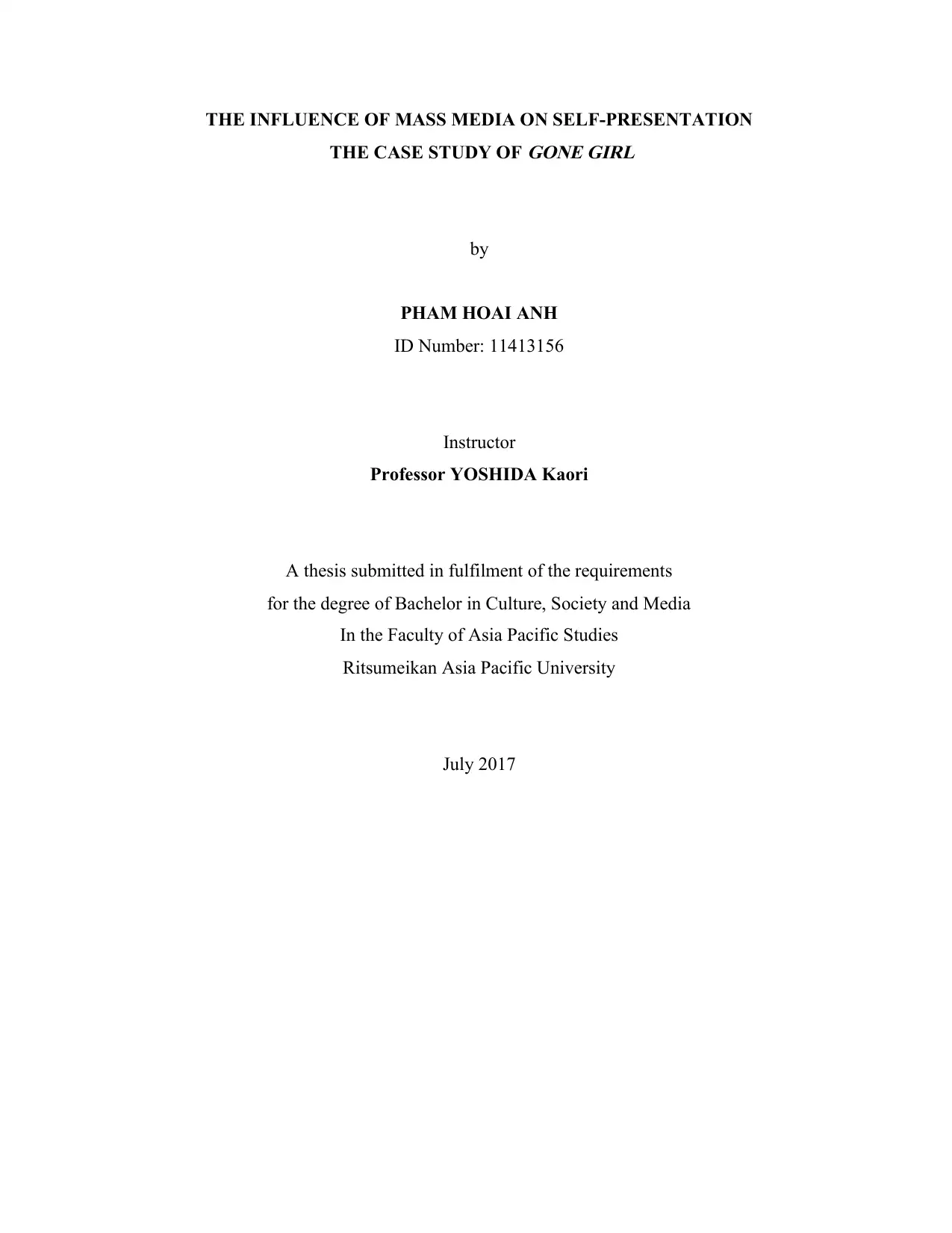
THE INFLUENCE OF MASS MEDIA ON SELF-PRESENTATION
THE CASE STUDY OF
GONE GIRL
by
PHAM HOAI ANH
ID Number: 11413156
Instructor
Professor YOSHIDA Kaori
A thesis submitted in fulfilment of the requirements
for the degree of Bachelor in Culture, Society and Media
In the Faculty of Asia Pacific Studies
Ritsumeikan Asia Pacific University
July 2017
THE CASE STUDY OF
GONE GIRL
by
PHAM HOAI ANH
ID Number: 11413156
Instructor
Professor YOSHIDA Kaori
A thesis submitted in fulfilment of the requirements
for the degree of Bachelor in Culture, Society and Media
In the Faculty of Asia Pacific Studies
Ritsumeikan Asia Pacific University
July 2017
Paraphrase This Document
Need a fresh take? Get an instant paraphrase of this document with our AI Paraphraser
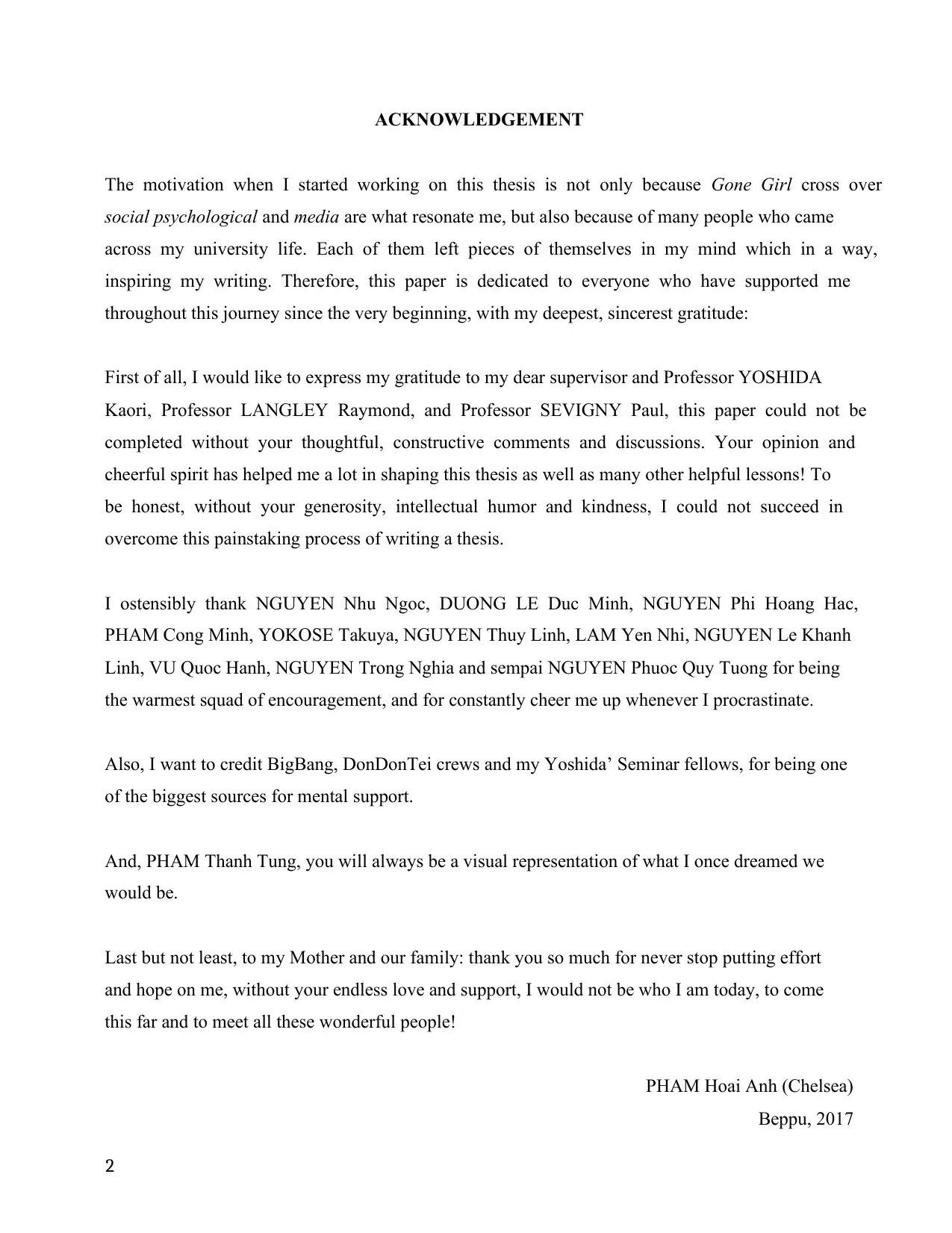
2
ACKNOWLEDGEMENT
The motivation when I started working on this thesis is not only because Gone Girl cross over
social psychological and media are what resonate me, but also because of many people who came
across my university life. Each of them left pieces of themselves in my mind which in a way,
inspiring my writing. Therefore, this paper is dedicated to everyone who have supported me
throughout this journey since the very beginning, with my deepest, sincerest gratitude:
First of all, I would like to express my gratitude to my dear supervisor and Professor YOSHIDA
Kaori, Professor LANGLEY Raymond, and Professor SEVIGNY Paul, this paper could not be
completed without your thoughtful, constructive comments and discussions. Your opinion and
cheerful spirit has helped me a lot in shaping this thesis as well as many other helpful lessons! To
be honest, without your generosity, intellectual humor and kindness, I could not succeed in
overcome this painstaking process of writing a thesis.
I ostensibly thank NGUYEN Nhu Ngoc, DUONG LE Duc Minh, NGUYEN Phi Hoang Hac,
PHAM Cong Minh, YOKOSE Takuya, NGUYEN Thuy Linh, LAM Yen Nhi, NGUYEN Le Khanh
Linh, VU Quoc Hanh, NGUYEN Trong Nghia and sempai NGUYEN Phuoc Quy Tuong for being
the warmest squad of encouragement, and for constantly cheer me up whenever I procrastinate.
Also, I want to credit BigBang, DonDonTei crews and my Yoshida’ Seminar fellows, for being one
of the biggest sources for mental support.
And, PHAM Thanh Tung, you will always be a visual representation of what I once dreamed we
would be.
Last but not least, to my Mother and our family: thank you so much for never stop putting effort
and hope on me, without your endless love and support, I would not be who I am today, to come
this far and to meet all these wonderful people!
PHAM Hoai Anh (Chelsea)
Beppu, 2017
ACKNOWLEDGEMENT
The motivation when I started working on this thesis is not only because Gone Girl cross over
social psychological and media are what resonate me, but also because of many people who came
across my university life. Each of them left pieces of themselves in my mind which in a way,
inspiring my writing. Therefore, this paper is dedicated to everyone who have supported me
throughout this journey since the very beginning, with my deepest, sincerest gratitude:
First of all, I would like to express my gratitude to my dear supervisor and Professor YOSHIDA
Kaori, Professor LANGLEY Raymond, and Professor SEVIGNY Paul, this paper could not be
completed without your thoughtful, constructive comments and discussions. Your opinion and
cheerful spirit has helped me a lot in shaping this thesis as well as many other helpful lessons! To
be honest, without your generosity, intellectual humor and kindness, I could not succeed in
overcome this painstaking process of writing a thesis.
I ostensibly thank NGUYEN Nhu Ngoc, DUONG LE Duc Minh, NGUYEN Phi Hoang Hac,
PHAM Cong Minh, YOKOSE Takuya, NGUYEN Thuy Linh, LAM Yen Nhi, NGUYEN Le Khanh
Linh, VU Quoc Hanh, NGUYEN Trong Nghia and sempai NGUYEN Phuoc Quy Tuong for being
the warmest squad of encouragement, and for constantly cheer me up whenever I procrastinate.
Also, I want to credit BigBang, DonDonTei crews and my Yoshida’ Seminar fellows, for being one
of the biggest sources for mental support.
And, PHAM Thanh Tung, you will always be a visual representation of what I once dreamed we
would be.
Last but not least, to my Mother and our family: thank you so much for never stop putting effort
and hope on me, without your endless love and support, I would not be who I am today, to come
this far and to meet all these wonderful people!
PHAM Hoai Anh (Chelsea)
Beppu, 2017
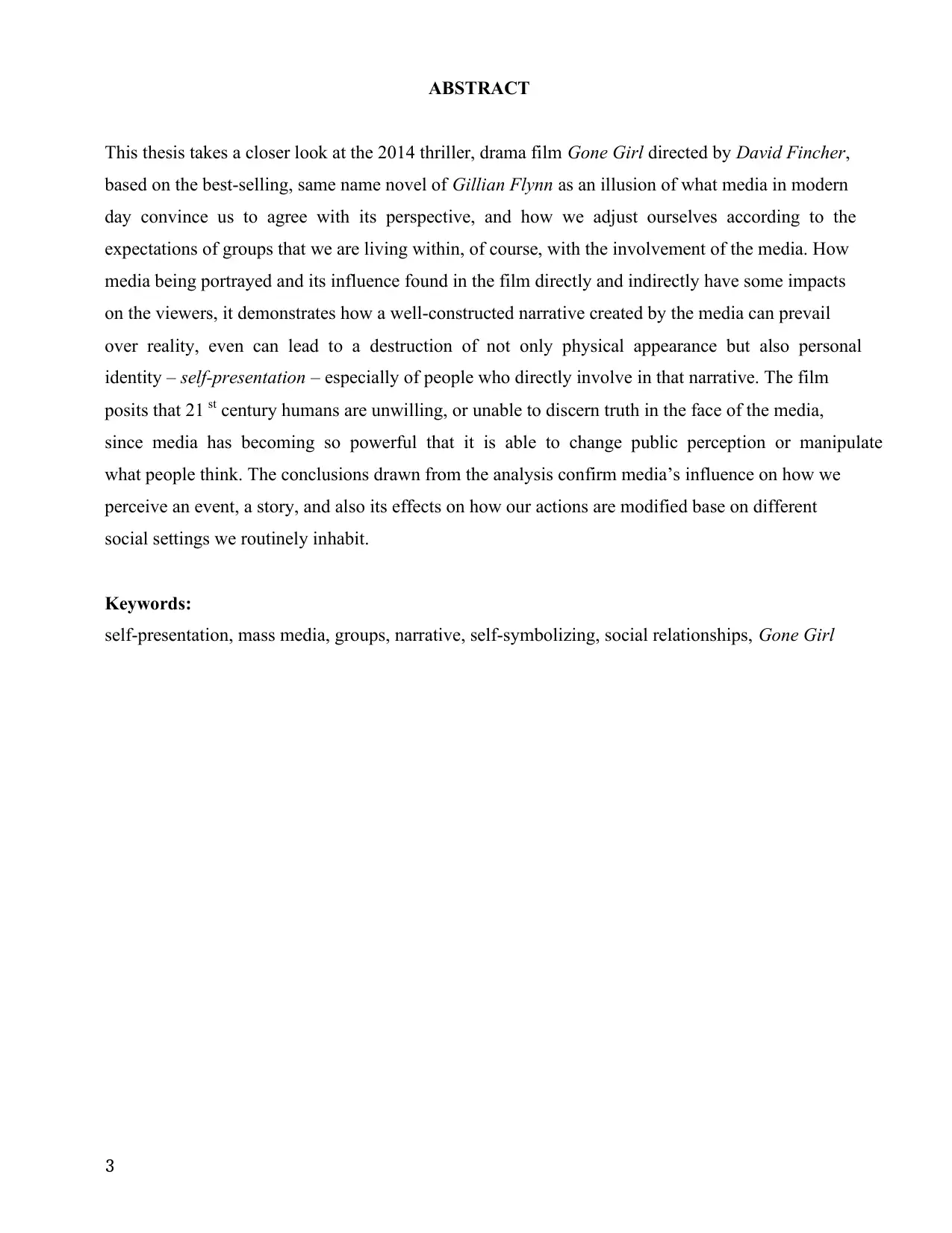
3
ABSTRACT
This thesis takes a closer look at the 2014 thriller, drama film Gone Girl directed by David Fincher,
based on the best-selling, same name novel of Gillian Flynn as an illusion of what media in modern
day convince us to agree with its perspective, and how we adjust ourselves according to the
expectations of groups that we are living within, of course, with the involvement of the media. How
media being portrayed and its influence found in the film directly and indirectly have some impacts
on the viewers, it demonstrates how a well-constructed narrative created by the media can prevail
over reality, even can lead to a destruction of not only physical appearance but also personal
identity – self-presentation – especially of people who directly involve in that narrative. The film
posits that 21 st century humans are unwilling, or unable to discern truth in the face of the media,
since media has becoming so powerful that it is able to change public perception or manipulate
what people think. The conclusions drawn from the analysis confirm media’s influence on how we
perceive an event, a story, and also its effects on how our actions are modified base on different
social settings we routinely inhabit.
Keywords:
self-presentation, mass media, groups, narrative, self-symbolizing, social relationships, Gone Girl
ABSTRACT
This thesis takes a closer look at the 2014 thriller, drama film Gone Girl directed by David Fincher,
based on the best-selling, same name novel of Gillian Flynn as an illusion of what media in modern
day convince us to agree with its perspective, and how we adjust ourselves according to the
expectations of groups that we are living within, of course, with the involvement of the media. How
media being portrayed and its influence found in the film directly and indirectly have some impacts
on the viewers, it demonstrates how a well-constructed narrative created by the media can prevail
over reality, even can lead to a destruction of not only physical appearance but also personal
identity – self-presentation – especially of people who directly involve in that narrative. The film
posits that 21 st century humans are unwilling, or unable to discern truth in the face of the media,
since media has becoming so powerful that it is able to change public perception or manipulate
what people think. The conclusions drawn from the analysis confirm media’s influence on how we
perceive an event, a story, and also its effects on how our actions are modified base on different
social settings we routinely inhabit.
Keywords:
self-presentation, mass media, groups, narrative, self-symbolizing, social relationships, Gone Girl
⊘ This is a preview!⊘
Do you want full access?
Subscribe today to unlock all pages.

Trusted by 1+ million students worldwide
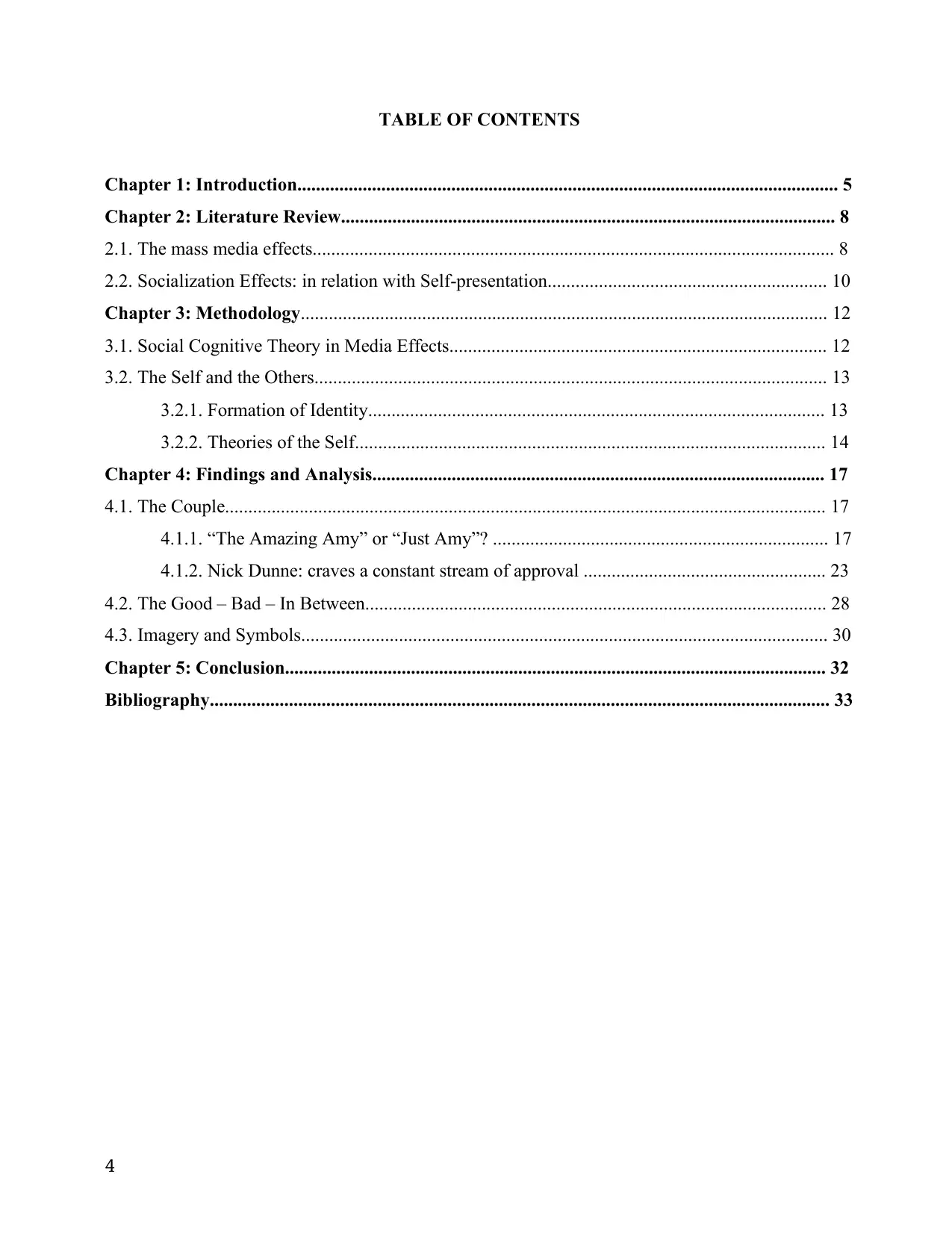
4
TABLE OF CONTENTS
Chapter 1: Introduction.................................................................................................................... 5
Chapter 2: Literature Review.......................................................................................................... 8
2.1. The mass media effects................................................................................................................ 8
2.2. Socialization Effects: in relation with Self-presentation............................................................ 10
Chapter 3: Methodology................................................................................................................. 12
3.1. Social Cognitive Theory in Media Effects................................................................................. 12
3.2. The Self and the Others.............................................................................................................. 13
3.2.1. Formation of Identity.................................................................................................. 13
3.2.2. Theories of the Self..................................................................................................... 14
Chapter 4: Findings and Analysis................................................................................................. 17
4.1. The Couple................................................................................................................................. 17
4.1.1. “The Amazing Amy” or “Just Amy”? ........................................................................ 17
4.1.2. Nick Dunne: craves a constant stream of approval .................................................... 23
4.2. The Good – Bad – In Between................................................................................................... 28
4.3. Imagery and Symbols................................................................................................................. 30
Chapter 5: Conclusion.................................................................................................................... 32
Bibliography..................................................................................................................................... 33
TABLE OF CONTENTS
Chapter 1: Introduction.................................................................................................................... 5
Chapter 2: Literature Review.......................................................................................................... 8
2.1. The mass media effects................................................................................................................ 8
2.2. Socialization Effects: in relation with Self-presentation............................................................ 10
Chapter 3: Methodology................................................................................................................. 12
3.1. Social Cognitive Theory in Media Effects................................................................................. 12
3.2. The Self and the Others.............................................................................................................. 13
3.2.1. Formation of Identity.................................................................................................. 13
3.2.2. Theories of the Self..................................................................................................... 14
Chapter 4: Findings and Analysis................................................................................................. 17
4.1. The Couple................................................................................................................................. 17
4.1.1. “The Amazing Amy” or “Just Amy”? ........................................................................ 17
4.1.2. Nick Dunne: craves a constant stream of approval .................................................... 23
4.2. The Good – Bad – In Between................................................................................................... 28
4.3. Imagery and Symbols................................................................................................................. 30
Chapter 5: Conclusion.................................................................................................................... 32
Bibliography..................................................................................................................................... 33
Paraphrase This Document
Need a fresh take? Get an instant paraphrase of this document with our AI Paraphraser
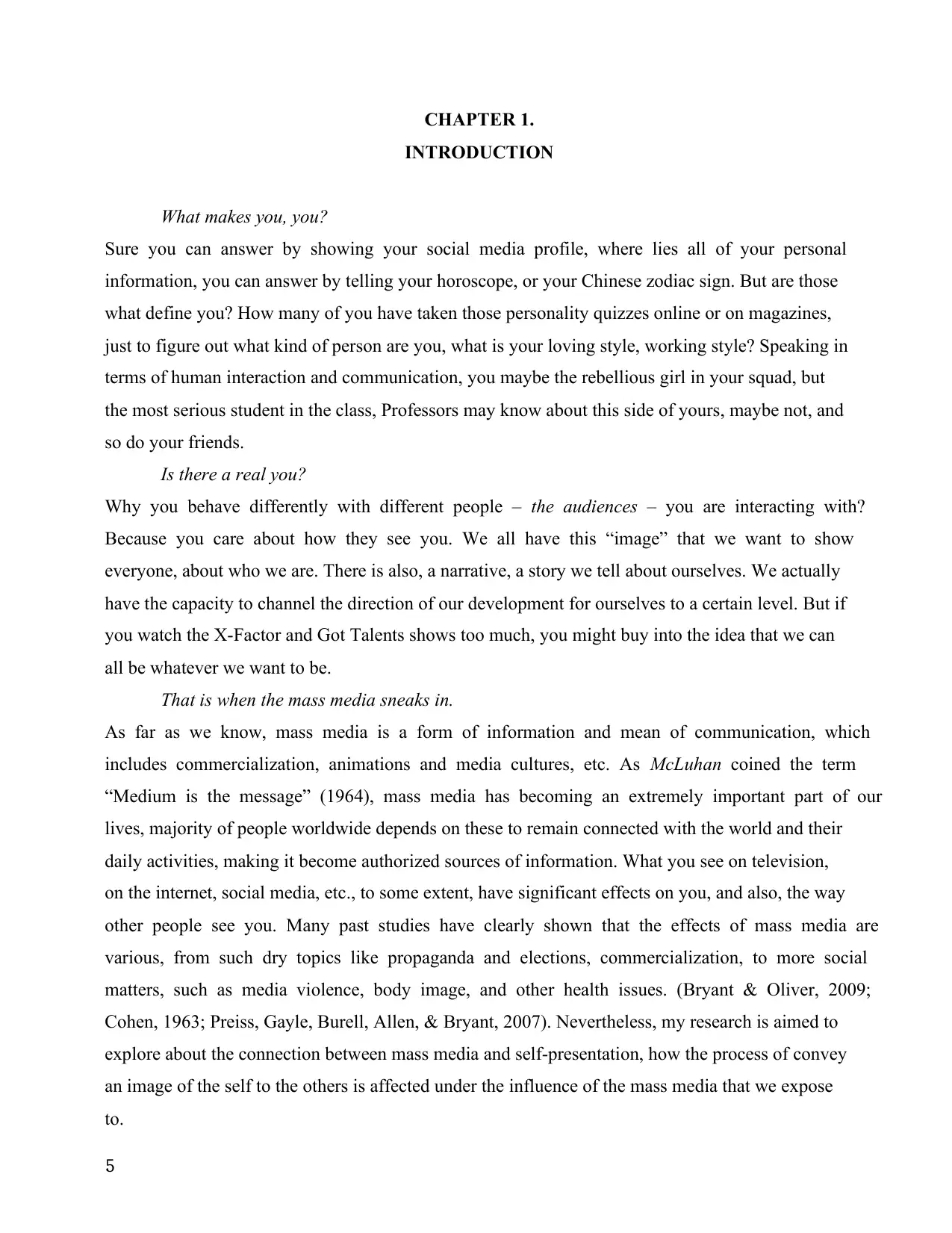
5
CHAPTER 1.
INTRODUCTION
What makes you, you?
Sure you can answer by showing your social media profile, where lies all of your personal
information, you can answer by telling your horoscope, or your Chinese zodiac sign. But are those
what define you? How many of you have taken those personality quizzes online or on magazines,
just to figure out what kind of person are you, what is your loving style, working style? Speaking in
terms of human interaction and communication, you maybe the rebellious girl in your squad, but
the most serious student in the class, Professors may know about this side of yours, maybe not, and
so do your friends.
Is there a real you?
Why you behave differently with different people – the audiences – you are interacting with?
Because you care about how they see you. We all have this “image” that we want to show
everyone, about who we are. There is also, a narrative, a story we tell about ourselves. We actually
have the capacity to channel the direction of our development for ourselves to a certain level. But if
you watch the X-Factor and Got Talents shows too much, you might buy into the idea that we can
all be whatever we want to be.
That is when the mass media sneaks in.
As far as we know, mass media is a form of information and mean of communication, which
includes commercialization, animations and media cultures, etc. As McLuhan coined the term
“Medium is the message” (1964), mass media has becoming an extremely important part of our
lives, majority of people worldwide depends on these to remain connected with the world and their
daily activities, making it become authorized sources of information. What you see on television,
on the internet, social media, etc., to some extent, have significant effects on you, and also, the way
other people see you. Many past studies have clearly shown that the effects of mass media are
various, from such dry topics like propaganda and elections, commercialization, to more social
matters, such as media violence, body image, and other health issues. (Bryant & Oliver, 2009;
Cohen, 1963; Preiss, Gayle, Burell, Allen, & Bryant, 2007). Nevertheless, my research is aimed to
explore about the connection between mass media and self-presentation, how the process of convey
an image of the self to the others is affected under the influence of the mass media that we expose
to.
CHAPTER 1.
INTRODUCTION
What makes you, you?
Sure you can answer by showing your social media profile, where lies all of your personal
information, you can answer by telling your horoscope, or your Chinese zodiac sign. But are those
what define you? How many of you have taken those personality quizzes online or on magazines,
just to figure out what kind of person are you, what is your loving style, working style? Speaking in
terms of human interaction and communication, you maybe the rebellious girl in your squad, but
the most serious student in the class, Professors may know about this side of yours, maybe not, and
so do your friends.
Is there a real you?
Why you behave differently with different people – the audiences – you are interacting with?
Because you care about how they see you. We all have this “image” that we want to show
everyone, about who we are. There is also, a narrative, a story we tell about ourselves. We actually
have the capacity to channel the direction of our development for ourselves to a certain level. But if
you watch the X-Factor and Got Talents shows too much, you might buy into the idea that we can
all be whatever we want to be.
That is when the mass media sneaks in.
As far as we know, mass media is a form of information and mean of communication, which
includes commercialization, animations and media cultures, etc. As McLuhan coined the term
“Medium is the message” (1964), mass media has becoming an extremely important part of our
lives, majority of people worldwide depends on these to remain connected with the world and their
daily activities, making it become authorized sources of information. What you see on television,
on the internet, social media, etc., to some extent, have significant effects on you, and also, the way
other people see you. Many past studies have clearly shown that the effects of mass media are
various, from such dry topics like propaganda and elections, commercialization, to more social
matters, such as media violence, body image, and other health issues. (Bryant & Oliver, 2009;
Cohen, 1963; Preiss, Gayle, Burell, Allen, & Bryant, 2007). Nevertheless, my research is aimed to
explore about the connection between mass media and self-presentation, how the process of convey
an image of the self to the others is affected under the influence of the mass media that we expose
to.
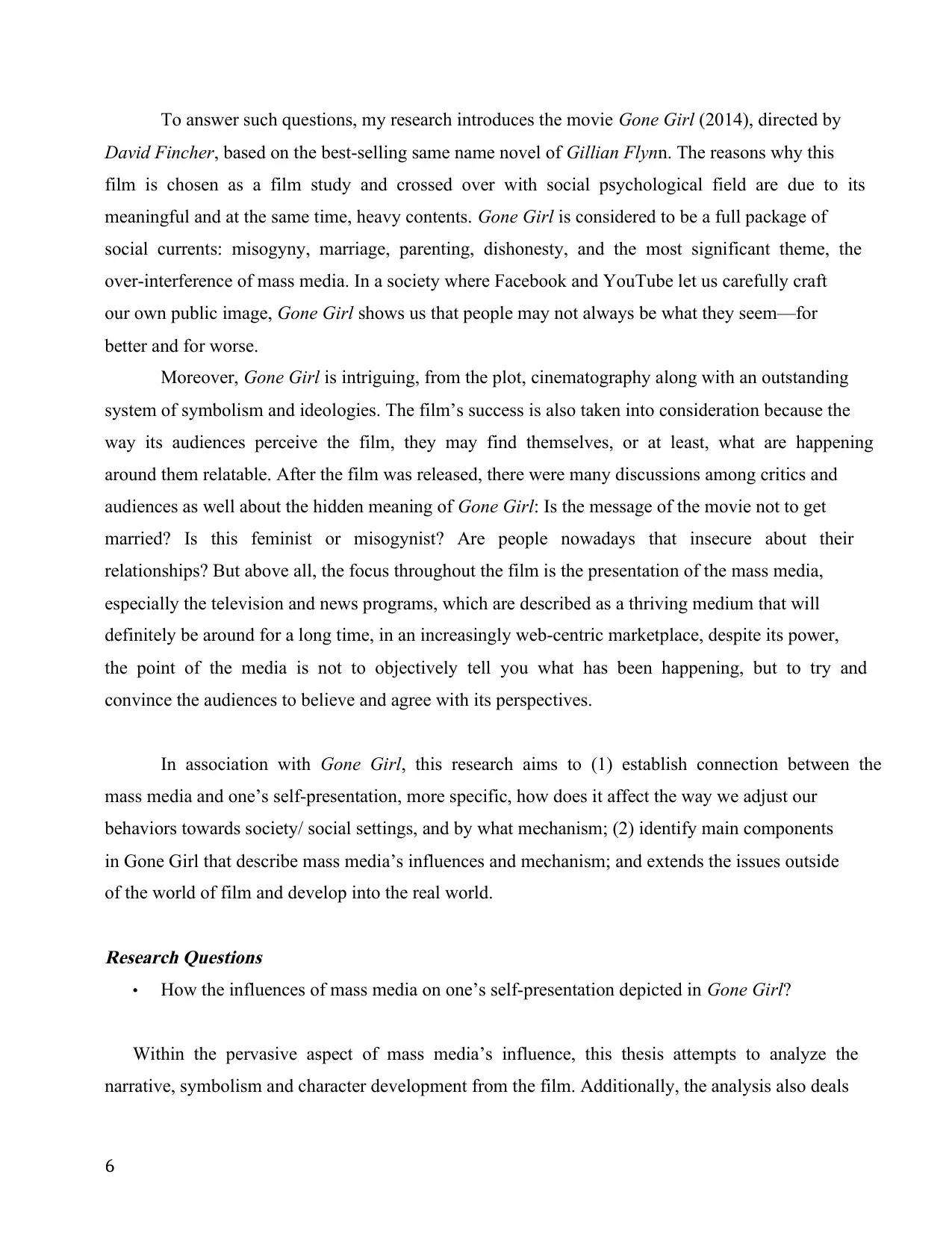
6
To answer such questions, my research introduces the movie Gone Girl (2014), directed by
David Fincher, based on the best-selling same name novel of Gillian Flynn. The reasons why this
film is chosen as a film study and crossed over with social psychological field are due to its
meaningful and at the same time, heavy contents. Gone Girl is considered to be a full package of
social currents: misogyny, marriage, parenting, dishonesty, and the most significant theme, the
over-interference of mass media. In a society where Facebook and YouTube let us carefully craft
our own public image, Gone Girl shows us that people may not always be what they seem—for
better and for worse.
Moreover, Gone Girl is intriguing, from the plot, cinematography along with an outstanding
system of symbolism and ideologies. The film’s success is also taken into consideration because the
way its audiences perceive the film, they may find themselves, or at least, what are happening
around them relatable. After the film was released, there were many discussions among critics and
audiences as well about the hidden meaning of Gone Girl: Is the message of the movie not to get
married? Is this feminist or misogynist? Are people nowadays that insecure about their
relationships? But above all, the focus throughout the film is the presentation of the mass media,
especially the television and news programs, which are described as a thriving medium that will
definitely be around for a long time, in an increasingly web-centric marketplace, despite its power,
the point of the media is not to objectively tell you what has been happening, but to try and
convince the audiences to believe and agree with its perspectives.
In association with Gone Girl, this research aims to (1) establish connection between the
mass media and one’s self-presentation, more specific, how does it affect the way we adjust our
behaviors towards society/ social settings, and by what mechanism; (2) identify main components
in Gone Girl that describe mass media’s influences and mechanism; and extends the issues outside
of the world of film and develop into the real world.
Research Questions
• How the influences of mass media on one’s self-presentation depicted in Gone Girl?
Within the pervasive aspect of mass media’s influence, this thesis attempts to analyze the
narrative, symbolism and character development from the film. Additionally, the analysis also deals
To answer such questions, my research introduces the movie Gone Girl (2014), directed by
David Fincher, based on the best-selling same name novel of Gillian Flynn. The reasons why this
film is chosen as a film study and crossed over with social psychological field are due to its
meaningful and at the same time, heavy contents. Gone Girl is considered to be a full package of
social currents: misogyny, marriage, parenting, dishonesty, and the most significant theme, the
over-interference of mass media. In a society where Facebook and YouTube let us carefully craft
our own public image, Gone Girl shows us that people may not always be what they seem—for
better and for worse.
Moreover, Gone Girl is intriguing, from the plot, cinematography along with an outstanding
system of symbolism and ideologies. The film’s success is also taken into consideration because the
way its audiences perceive the film, they may find themselves, or at least, what are happening
around them relatable. After the film was released, there were many discussions among critics and
audiences as well about the hidden meaning of Gone Girl: Is the message of the movie not to get
married? Is this feminist or misogynist? Are people nowadays that insecure about their
relationships? But above all, the focus throughout the film is the presentation of the mass media,
especially the television and news programs, which are described as a thriving medium that will
definitely be around for a long time, in an increasingly web-centric marketplace, despite its power,
the point of the media is not to objectively tell you what has been happening, but to try and
convince the audiences to believe and agree with its perspectives.
In association with Gone Girl, this research aims to (1) establish connection between the
mass media and one’s self-presentation, more specific, how does it affect the way we adjust our
behaviors towards society/ social settings, and by what mechanism; (2) identify main components
in Gone Girl that describe mass media’s influences and mechanism; and extends the issues outside
of the world of film and develop into the real world.
Research Questions
• How the influences of mass media on one’s self-presentation depicted in Gone Girl?
Within the pervasive aspect of mass media’s influence, this thesis attempts to analyze the
narrative, symbolism and character development from the film. Additionally, the analysis also deals
⊘ This is a preview!⊘
Do you want full access?
Subscribe today to unlock all pages.

Trusted by 1+ million students worldwide
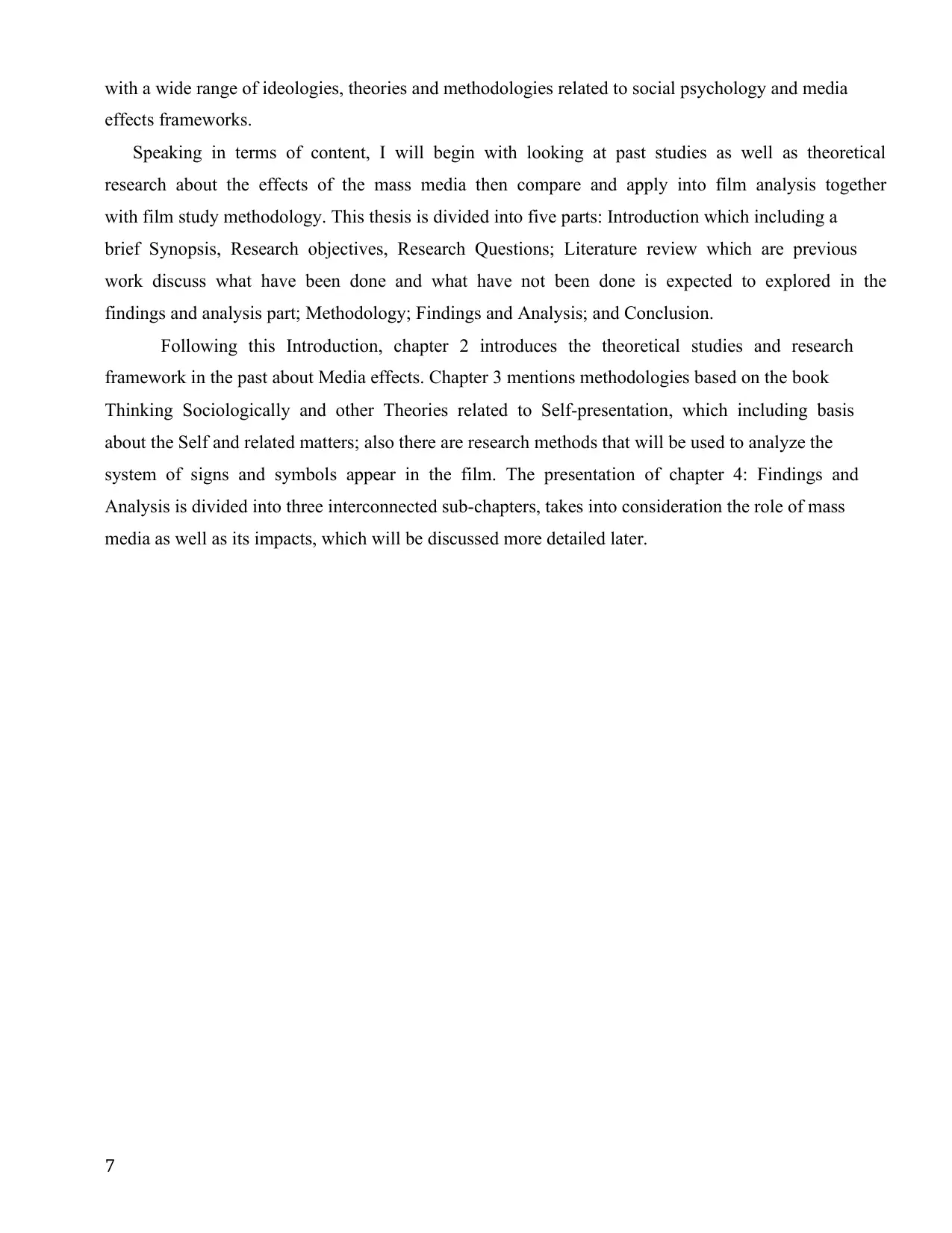
7
with a wide range of ideologies, theories and methodologies related to social psychology and media
effects frameworks.
Speaking in terms of content, I will begin with looking at past studies as well as theoretical
research about the effects of the mass media then compare and apply into film analysis together
with film study methodology. This thesis is divided into five parts: Introduction which including a
brief Synopsis, Research objectives, Research Questions; Literature review which are previous
work discuss what have been done and what have not been done is expected to explored in the
findings and analysis part; Methodology; Findings and Analysis; and Conclusion.
Following this Introduction, chapter 2 introduces the theoretical studies and research
framework in the past about Media effects. Chapter 3 mentions methodologies based on the book
Thinking Sociologically and other Theories related to Self-presentation, which including basis
about the Self and related matters; also there are research methods that will be used to analyze the
system of signs and symbols appear in the film. The presentation of chapter 4: Findings and
Analysis is divided into three interconnected sub-chapters, takes into consideration the role of mass
media as well as its impacts, which will be discussed more detailed later.
with a wide range of ideologies, theories and methodologies related to social psychology and media
effects frameworks.
Speaking in terms of content, I will begin with looking at past studies as well as theoretical
research about the effects of the mass media then compare and apply into film analysis together
with film study methodology. This thesis is divided into five parts: Introduction which including a
brief Synopsis, Research objectives, Research Questions; Literature review which are previous
work discuss what have been done and what have not been done is expected to explored in the
findings and analysis part; Methodology; Findings and Analysis; and Conclusion.
Following this Introduction, chapter 2 introduces the theoretical studies and research
framework in the past about Media effects. Chapter 3 mentions methodologies based on the book
Thinking Sociologically and other Theories related to Self-presentation, which including basis
about the Self and related matters; also there are research methods that will be used to analyze the
system of signs and symbols appear in the film. The presentation of chapter 4: Findings and
Analysis is divided into three interconnected sub-chapters, takes into consideration the role of mass
media as well as its impacts, which will be discussed more detailed later.
Paraphrase This Document
Need a fresh take? Get an instant paraphrase of this document with our AI Paraphraser
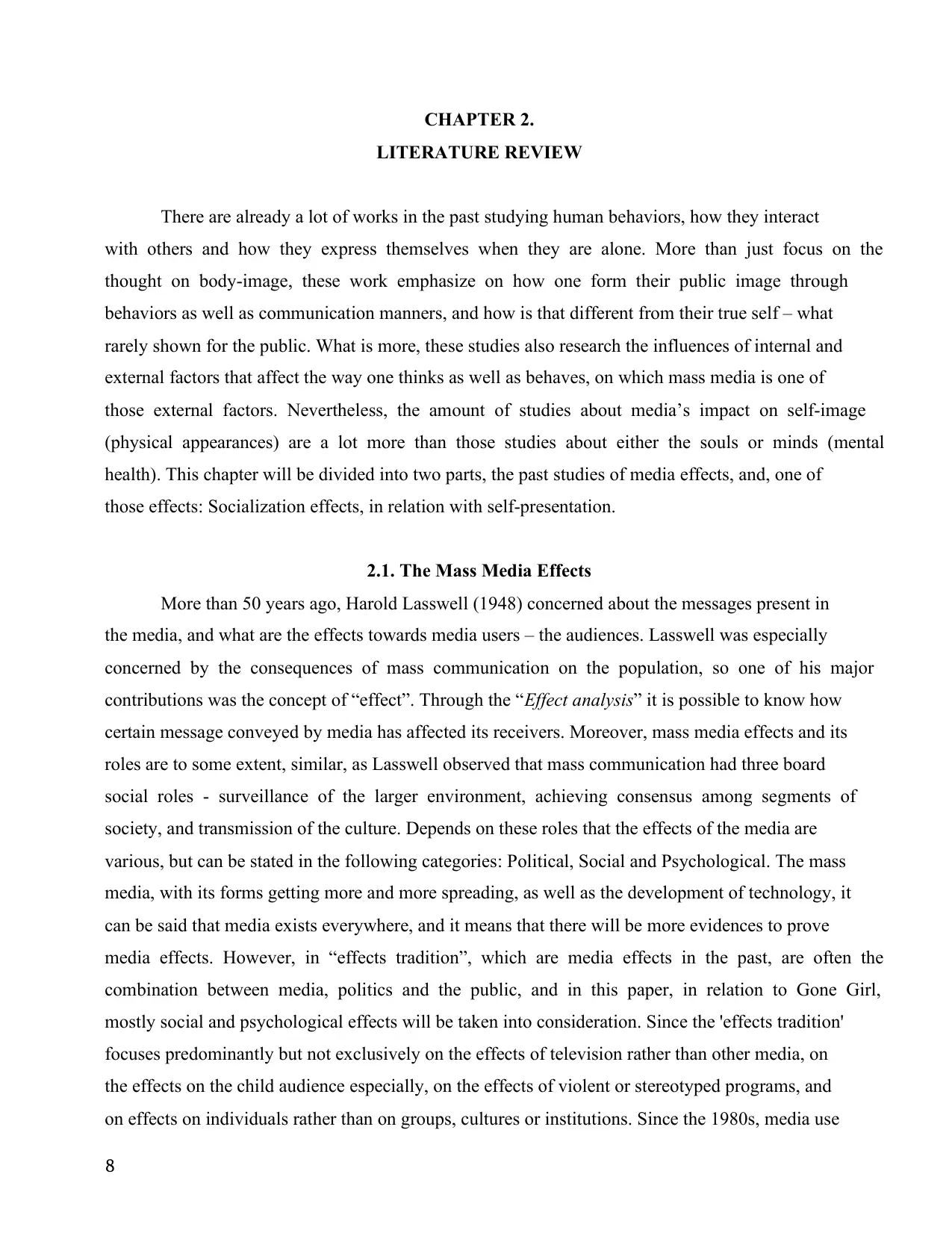
8
CHAPTER 2.
LITERATURE REVIEW
There are already a lot of works in the past studying human behaviors, how they interact
with others and how they express themselves when they are alone. More than just focus on the
thought on body-image, these work emphasize on how one form their public image through
behaviors as well as communication manners, and how is that different from their true self – what
rarely shown for the public. What is more, these studies also research the influences of internal and
external factors that affect the way one thinks as well as behaves, on which mass media is one of
those external factors. Nevertheless, the amount of studies about media’s impact on self-image
(physical appearances) are a lot more than those studies about either the souls or minds (mental
health). This chapter will be divided into two parts, the past studies of media effects, and, one of
those effects: Socialization effects, in relation with self-presentation.
2.1. The Mass Media Effects
More than 50 years ago, Harold Lasswell (1948) concerned about the messages present in
the media, and what are the effects towards media users – the audiences. Lasswell was especially
concerned by the consequences of mass communication on the population, so one of his major
contributions was the concept of “effect”. Through the “Effect analysis” it is possible to know how
certain message conveyed by media has affected its receivers. Moreover, mass media effects and its
roles are to some extent, similar, as Lasswell observed that mass communication had three board
social roles - surveillance of the larger environment, achieving consensus among segments of
society, and transmission of the culture. Depends on these roles that the effects of the media are
various, but can be stated in the following categories: Political, Social and Psychological. The mass
media, with its forms getting more and more spreading, as well as the development of technology, it
can be said that media exists everywhere, and it means that there will be more evidences to prove
media effects. However, in “effects tradition”, which are media effects in the past, are often the
combination between media, politics and the public, and in this paper, in relation to Gone Girl,
mostly social and psychological effects will be taken into consideration. Since the 'effects tradition'
focuses predominantly but not exclusively on the effects of television rather than other media, on
the effects on the child audience especially, on the effects of violent or stereotyped programs, and
on effects on individuals rather than on groups, cultures or institutions. Since the 1980s, media use
CHAPTER 2.
LITERATURE REVIEW
There are already a lot of works in the past studying human behaviors, how they interact
with others and how they express themselves when they are alone. More than just focus on the
thought on body-image, these work emphasize on how one form their public image through
behaviors as well as communication manners, and how is that different from their true self – what
rarely shown for the public. What is more, these studies also research the influences of internal and
external factors that affect the way one thinks as well as behaves, on which mass media is one of
those external factors. Nevertheless, the amount of studies about media’s impact on self-image
(physical appearances) are a lot more than those studies about either the souls or minds (mental
health). This chapter will be divided into two parts, the past studies of media effects, and, one of
those effects: Socialization effects, in relation with self-presentation.
2.1. The Mass Media Effects
More than 50 years ago, Harold Lasswell (1948) concerned about the messages present in
the media, and what are the effects towards media users – the audiences. Lasswell was especially
concerned by the consequences of mass communication on the population, so one of his major
contributions was the concept of “effect”. Through the “Effect analysis” it is possible to know how
certain message conveyed by media has affected its receivers. Moreover, mass media effects and its
roles are to some extent, similar, as Lasswell observed that mass communication had three board
social roles - surveillance of the larger environment, achieving consensus among segments of
society, and transmission of the culture. Depends on these roles that the effects of the media are
various, but can be stated in the following categories: Political, Social and Psychological. The mass
media, with its forms getting more and more spreading, as well as the development of technology, it
can be said that media exists everywhere, and it means that there will be more evidences to prove
media effects. However, in “effects tradition”, which are media effects in the past, are often the
combination between media, politics and the public, and in this paper, in relation to Gone Girl,
mostly social and psychological effects will be taken into consideration. Since the 'effects tradition'
focuses predominantly but not exclusively on the effects of television rather than other media, on
the effects on the child audience especially, on the effects of violent or stereotyped programs, and
on effects on individuals rather than on groups, cultures or institutions. Since the 1980s, media use
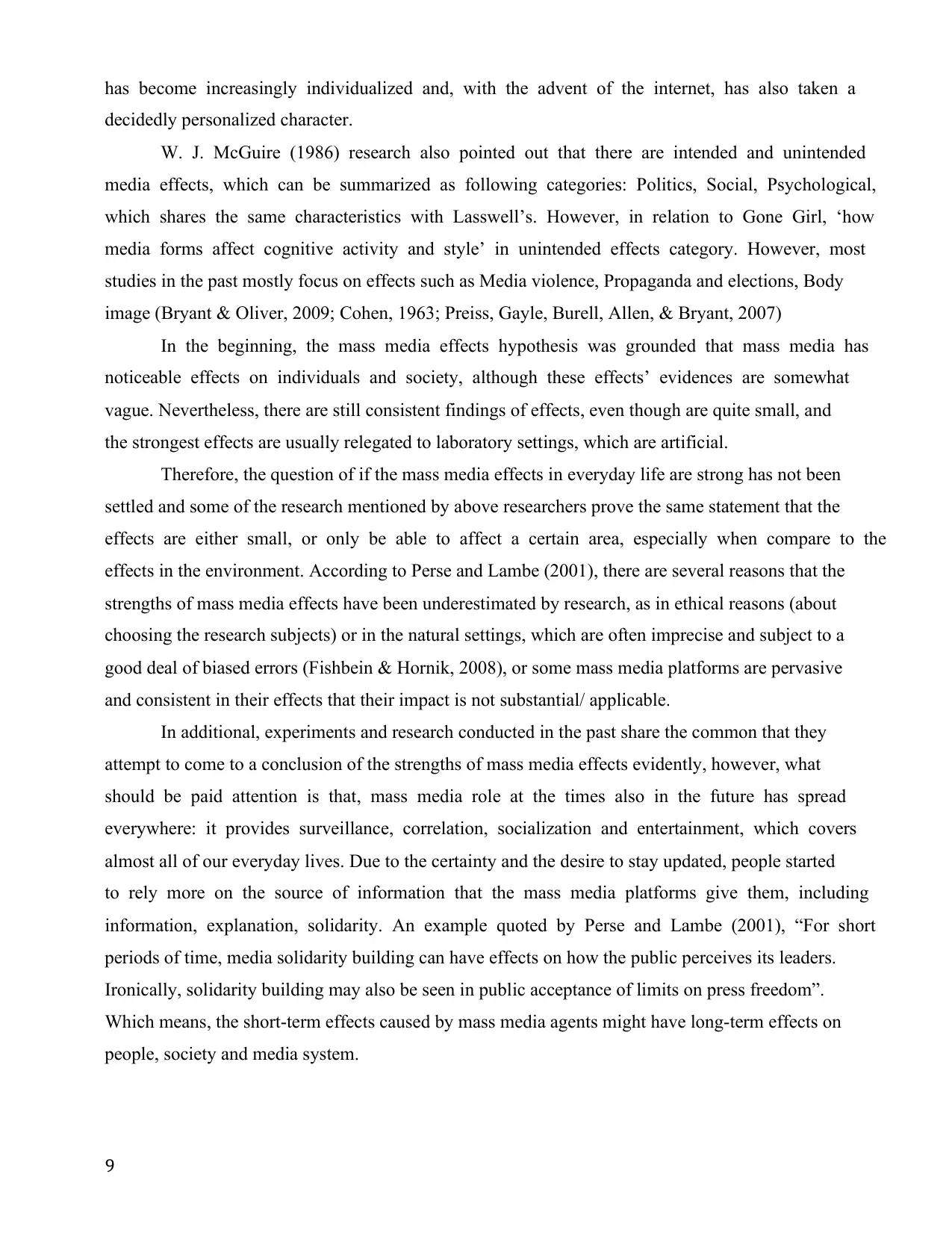
9
has become increasingly individualized and, with the advent of the internet, has also taken a
decidedly personalized character.
W. J. McGuire (1986) research also pointed out that there are intended and unintended
media effects, which can be summarized as following categories: Politics, Social, Psychological,
which shares the same characteristics with Lasswell’s. However, in relation to Gone Girl, ‘how
media forms affect cognitive activity and style’ in unintended effects category. However, most
studies in the past mostly focus on effects such as Media violence, Propaganda and elections, Body
image (Bryant & Oliver, 2009; Cohen, 1963; Preiss, Gayle, Burell, Allen, & Bryant, 2007)
In the beginning, the mass media effects hypothesis was grounded that mass media has
noticeable effects on individuals and society, although these effects’ evidences are somewhat
vague. Nevertheless, there are still consistent findings of effects, even though are quite small, and
the strongest effects are usually relegated to laboratory settings, which are artificial.
Therefore, the question of if the mass media effects in everyday life are strong has not been
settled and some of the research mentioned by above researchers prove the same statement that the
effects are either small, or only be able to affect a certain area, especially when compare to the
effects in the environment. According to Perse and Lambe (2001), there are several reasons that the
strengths of mass media effects have been underestimated by research, as in ethical reasons (about
choosing the research subjects) or in the natural settings, which are often imprecise and subject to a
good deal of biased errors (Fishbein & Hornik, 2008), or some mass media platforms are pervasive
and consistent in their effects that their impact is not substantial/ applicable.
In additional, experiments and research conducted in the past share the common that they
attempt to come to a conclusion of the strengths of mass media effects evidently, however, what
should be paid attention is that, mass media role at the times also in the future has spread
everywhere: it provides surveillance, correlation, socialization and entertainment, which covers
almost all of our everyday lives. Due to the certainty and the desire to stay updated, people started
to rely more on the source of information that the mass media platforms give them, including
information, explanation, solidarity. An example quoted by Perse and Lambe (2001), “For short
periods of time, media solidarity building can have effects on how the public perceives its leaders.
Ironically, solidarity building may also be seen in public acceptance of limits on press freedom”.
Which means, the short-term effects caused by mass media agents might have long-term effects on
people, society and media system.
has become increasingly individualized and, with the advent of the internet, has also taken a
decidedly personalized character.
W. J. McGuire (1986) research also pointed out that there are intended and unintended
media effects, which can be summarized as following categories: Politics, Social, Psychological,
which shares the same characteristics with Lasswell’s. However, in relation to Gone Girl, ‘how
media forms affect cognitive activity and style’ in unintended effects category. However, most
studies in the past mostly focus on effects such as Media violence, Propaganda and elections, Body
image (Bryant & Oliver, 2009; Cohen, 1963; Preiss, Gayle, Burell, Allen, & Bryant, 2007)
In the beginning, the mass media effects hypothesis was grounded that mass media has
noticeable effects on individuals and society, although these effects’ evidences are somewhat
vague. Nevertheless, there are still consistent findings of effects, even though are quite small, and
the strongest effects are usually relegated to laboratory settings, which are artificial.
Therefore, the question of if the mass media effects in everyday life are strong has not been
settled and some of the research mentioned by above researchers prove the same statement that the
effects are either small, or only be able to affect a certain area, especially when compare to the
effects in the environment. According to Perse and Lambe (2001), there are several reasons that the
strengths of mass media effects have been underestimated by research, as in ethical reasons (about
choosing the research subjects) or in the natural settings, which are often imprecise and subject to a
good deal of biased errors (Fishbein & Hornik, 2008), or some mass media platforms are pervasive
and consistent in their effects that their impact is not substantial/ applicable.
In additional, experiments and research conducted in the past share the common that they
attempt to come to a conclusion of the strengths of mass media effects evidently, however, what
should be paid attention is that, mass media role at the times also in the future has spread
everywhere: it provides surveillance, correlation, socialization and entertainment, which covers
almost all of our everyday lives. Due to the certainty and the desire to stay updated, people started
to rely more on the source of information that the mass media platforms give them, including
information, explanation, solidarity. An example quoted by Perse and Lambe (2001), “For short
periods of time, media solidarity building can have effects on how the public perceives its leaders.
Ironically, solidarity building may also be seen in public acceptance of limits on press freedom”.
Which means, the short-term effects caused by mass media agents might have long-term effects on
people, society and media system.
⊘ This is a preview!⊘
Do you want full access?
Subscribe today to unlock all pages.

Trusted by 1+ million students worldwide
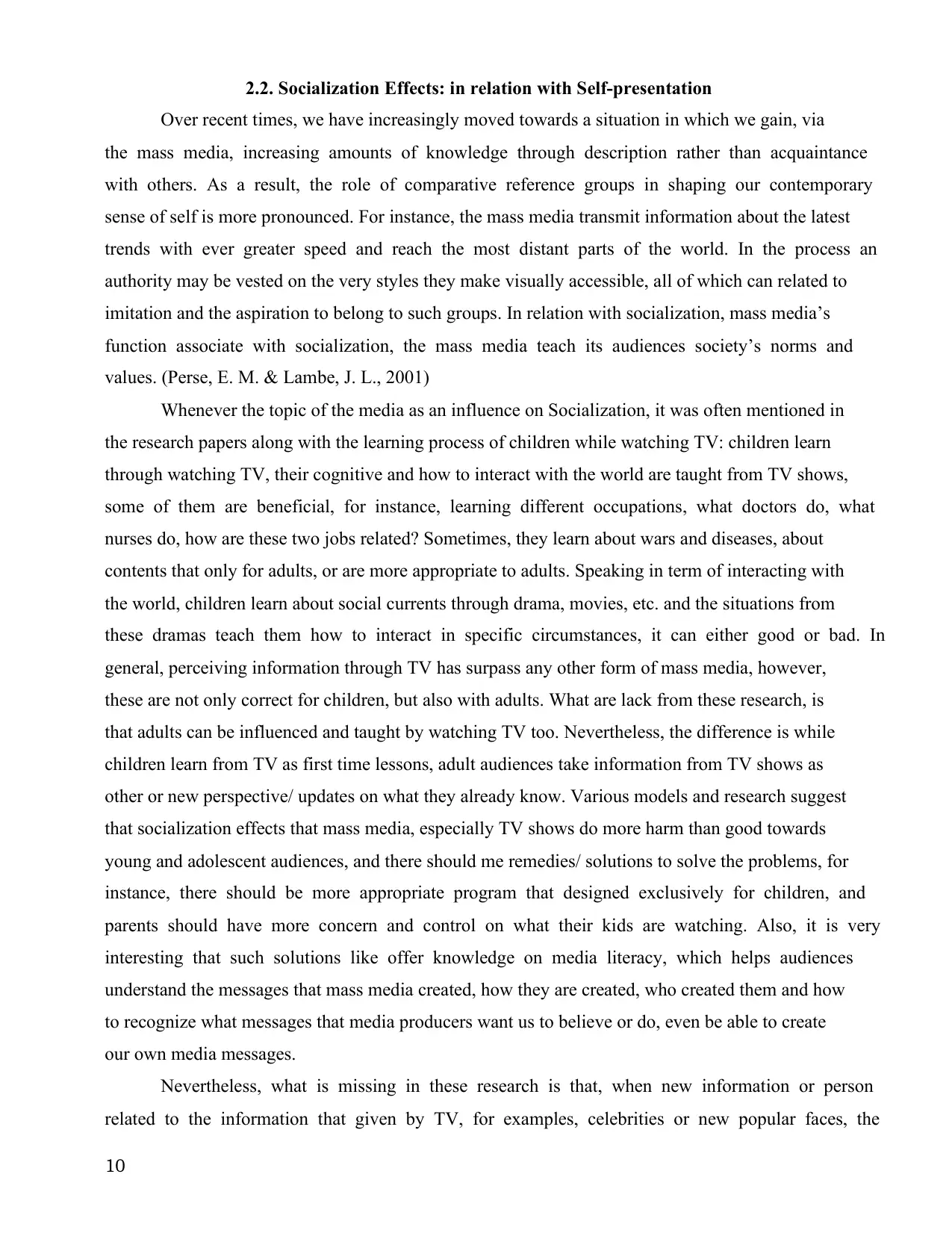
10
2.2. Socialization Effects: in relation with Self-presentation
Over recent times, we have increasingly moved towards a situation in which we gain, via
the mass media, increasing amounts of knowledge through description rather than acquaintance
with others. As a result, the role of comparative reference groups in shaping our contemporary
sense of self is more pronounced. For instance, the mass media transmit information about the latest
trends with ever greater speed and reach the most distant parts of the world. In the process an
authority may be vested on the very styles they make visually accessible, all of which can related to
imitation and the aspiration to belong to such groups. In relation with socialization, mass media’s
function associate with socialization, the mass media teach its audiences society’s norms and
values. (Perse, E. M. & Lambe, J. L., 2001)
Whenever the topic of the media as an influence on Socialization, it was often mentioned in
the research papers along with the learning process of children while watching TV: children learn
through watching TV, their cognitive and how to interact with the world are taught from TV shows,
some of them are beneficial, for instance, learning different occupations, what doctors do, what
nurses do, how are these two jobs related? Sometimes, they learn about wars and diseases, about
contents that only for adults, or are more appropriate to adults. Speaking in term of interacting with
the world, children learn about social currents through drama, movies, etc. and the situations from
these dramas teach them how to interact in specific circumstances, it can either good or bad. In
general, perceiving information through TV has surpass any other form of mass media, however,
these are not only correct for children, but also with adults. What are lack from these research, is
that adults can be influenced and taught by watching TV too. Nevertheless, the difference is while
children learn from TV as first time lessons, adult audiences take information from TV shows as
other or new perspective/ updates on what they already know. Various models and research suggest
that socialization effects that mass media, especially TV shows do more harm than good towards
young and adolescent audiences, and there should me remedies/ solutions to solve the problems, for
instance, there should be more appropriate program that designed exclusively for children, and
parents should have more concern and control on what their kids are watching. Also, it is very
interesting that such solutions like offer knowledge on media literacy, which helps audiences
understand the messages that mass media created, how they are created, who created them and how
to recognize what messages that media producers want us to believe or do, even be able to create
our own media messages.
Nevertheless, what is missing in these research is that, when new information or person
related to the information that given by TV, for examples, celebrities or new popular faces, the
2.2. Socialization Effects: in relation with Self-presentation
Over recent times, we have increasingly moved towards a situation in which we gain, via
the mass media, increasing amounts of knowledge through description rather than acquaintance
with others. As a result, the role of comparative reference groups in shaping our contemporary
sense of self is more pronounced. For instance, the mass media transmit information about the latest
trends with ever greater speed and reach the most distant parts of the world. In the process an
authority may be vested on the very styles they make visually accessible, all of which can related to
imitation and the aspiration to belong to such groups. In relation with socialization, mass media’s
function associate with socialization, the mass media teach its audiences society’s norms and
values. (Perse, E. M. & Lambe, J. L., 2001)
Whenever the topic of the media as an influence on Socialization, it was often mentioned in
the research papers along with the learning process of children while watching TV: children learn
through watching TV, their cognitive and how to interact with the world are taught from TV shows,
some of them are beneficial, for instance, learning different occupations, what doctors do, what
nurses do, how are these two jobs related? Sometimes, they learn about wars and diseases, about
contents that only for adults, or are more appropriate to adults. Speaking in term of interacting with
the world, children learn about social currents through drama, movies, etc. and the situations from
these dramas teach them how to interact in specific circumstances, it can either good or bad. In
general, perceiving information through TV has surpass any other form of mass media, however,
these are not only correct for children, but also with adults. What are lack from these research, is
that adults can be influenced and taught by watching TV too. Nevertheless, the difference is while
children learn from TV as first time lessons, adult audiences take information from TV shows as
other or new perspective/ updates on what they already know. Various models and research suggest
that socialization effects that mass media, especially TV shows do more harm than good towards
young and adolescent audiences, and there should me remedies/ solutions to solve the problems, for
instance, there should be more appropriate program that designed exclusively for children, and
parents should have more concern and control on what their kids are watching. Also, it is very
interesting that such solutions like offer knowledge on media literacy, which helps audiences
understand the messages that mass media created, how they are created, who created them and how
to recognize what messages that media producers want us to believe or do, even be able to create
our own media messages.
Nevertheless, what is missing in these research is that, when new information or person
related to the information that given by TV, for examples, celebrities or new popular faces, the
Paraphrase This Document
Need a fresh take? Get an instant paraphrase of this document with our AI Paraphraser
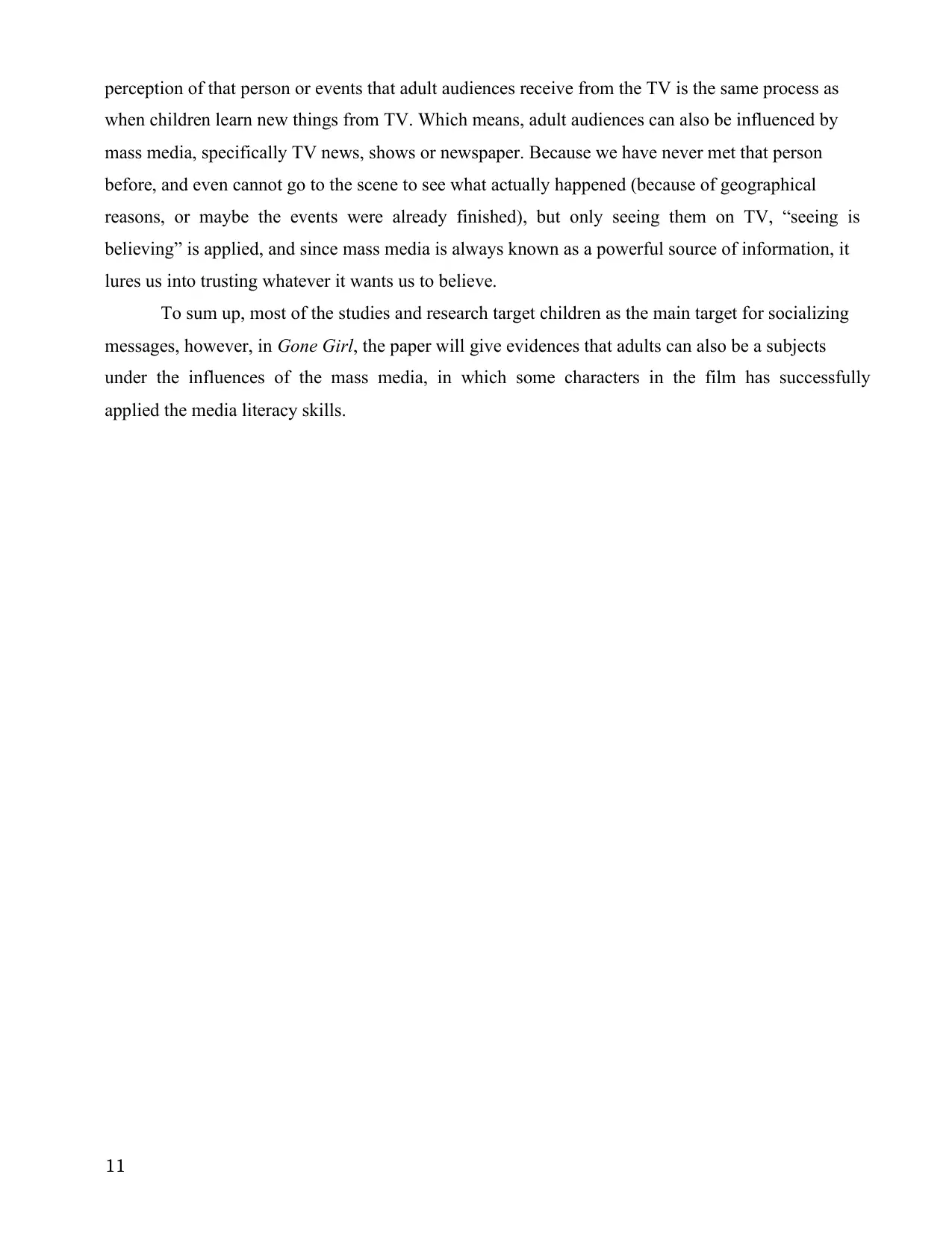
11
perception of that person or events that adult audiences receive from the TV is the same process as
when children learn new things from TV. Which means, adult audiences can also be influenced by
mass media, specifically TV news, shows or newspaper. Because we have never met that person
before, and even cannot go to the scene to see what actually happened (because of geographical
reasons, or maybe the events were already finished), but only seeing them on TV, “seeing is
believing” is applied, and since mass media is always known as a powerful source of information, it
lures us into trusting whatever it wants us to believe.
To sum up, most of the studies and research target children as the main target for socializing
messages, however, in Gone Girl, the paper will give evidences that adults can also be a subjects
under the influences of the mass media, in which some characters in the film has successfully
applied the media literacy skills.
perception of that person or events that adult audiences receive from the TV is the same process as
when children learn new things from TV. Which means, adult audiences can also be influenced by
mass media, specifically TV news, shows or newspaper. Because we have never met that person
before, and even cannot go to the scene to see what actually happened (because of geographical
reasons, or maybe the events were already finished), but only seeing them on TV, “seeing is
believing” is applied, and since mass media is always known as a powerful source of information, it
lures us into trusting whatever it wants us to believe.
To sum up, most of the studies and research target children as the main target for socializing
messages, however, in Gone Girl, the paper will give evidences that adults can also be a subjects
under the influences of the mass media, in which some characters in the film has successfully
applied the media literacy skills.

12
CHAPTER 3.
METHODOLOGY
3.1. Social Cognitive Theory in Media effects
Originally developed by Albert Bandura in the 1960s, also known as “social learning” or
“observational learning”. It is psychosocial mechanisms through which symbolic communication
human thought, affect and action. In short, humans learn behaviors by watching actions from others
and mimic them. In communication mass media theory, also can be simply understood as the
process of receiving information of actions presented through media devices (TV, news, etc.), the
framework has been developed into two separated principles in order to explain actual mechanisms
that happen.
Firstly, Principle 1 (Sufficiency Principle): when people construct judgement, they typically
do not search memory for all information that is relevant to the judgement, but instead retrieve only
a small subset of the information available. Moreover, the criterion for what is retrieved is
“sufficiency”. That is, only the information that is sufficient to construct the judgement is retrieved,
and the determinants of sufficiency are related to concepts such as motivation and ability to process
information (Wyer & Srull, 1989)
Secondly, Principle 2 (Accessibility Principle): the information that comes most readily to
mind will be the information that comprises the “small subset” of available information that is
retrieved and, in turn, is the information that is most likely to be used in constructing a judgement
(Carlston & Smith, 1996; Higgins, 1989; Wyer, 1980)
To sum up, people’s judgement on a subject or event under the Social Cognitive Theory
about an event related to media is not always correct and be affected under the influence of what
mass media gives them.
CHAPTER 3.
METHODOLOGY
3.1. Social Cognitive Theory in Media effects
Originally developed by Albert Bandura in the 1960s, also known as “social learning” or
“observational learning”. It is psychosocial mechanisms through which symbolic communication
human thought, affect and action. In short, humans learn behaviors by watching actions from others
and mimic them. In communication mass media theory, also can be simply understood as the
process of receiving information of actions presented through media devices (TV, news, etc.), the
framework has been developed into two separated principles in order to explain actual mechanisms
that happen.
Firstly, Principle 1 (Sufficiency Principle): when people construct judgement, they typically
do not search memory for all information that is relevant to the judgement, but instead retrieve only
a small subset of the information available. Moreover, the criterion for what is retrieved is
“sufficiency”. That is, only the information that is sufficient to construct the judgement is retrieved,
and the determinants of sufficiency are related to concepts such as motivation and ability to process
information (Wyer & Srull, 1989)
Secondly, Principle 2 (Accessibility Principle): the information that comes most readily to
mind will be the information that comprises the “small subset” of available information that is
retrieved and, in turn, is the information that is most likely to be used in constructing a judgement
(Carlston & Smith, 1996; Higgins, 1989; Wyer, 1980)
To sum up, people’s judgement on a subject or event under the Social Cognitive Theory
about an event related to media is not always correct and be affected under the influence of what
mass media gives them.
⊘ This is a preview!⊘
Do you want full access?
Subscribe today to unlock all pages.

Trusted by 1+ million students worldwide
1 out of 35
Your All-in-One AI-Powered Toolkit for Academic Success.
+13062052269
info@desklib.com
Available 24*7 on WhatsApp / Email
![[object Object]](/_next/static/media/star-bottom.7253800d.svg)
Unlock your academic potential
Copyright © 2020–2025 A2Z Services. All Rights Reserved. Developed and managed by ZUCOL.